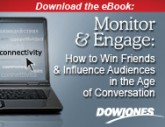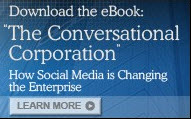Posted on September 2, 2010. Filed under: disaster response, Social Media | Tags: BP, crisis communications, Facebook, Social Media, Twitter |
The embattled oil giant BP, which has in recent history repackaged itself as an environmental visionary by calling itself “Beyond Petroleum,” is now facing a future with an unwelcome legacy: forefather of the worst oil spill in American history. From the onset of the Deepwater Horizon blowout, BP’s communicators fought an uphill battle against an unrelenting backdrop of an ever-present live TV image of the untamed well head — while its infuriatingly vague plans prompted media outlets to pile on.
Worse yet, BP’s public relations team had to ease a riled media landscape early in the crisis after BP CEO Tony Hayward said he “wanted his life back.” And if BP didn’t have enough headaches, the company was brandjacked when a new satirical Twitter handle (@BPGlobalPR) surfaced posing as BP’s official PR machine, both deriding and frustrating its communications efforts. In fact, the fake site attracted tens of thousands of followers, far and away outnumbering followers on BP’s real Twitter stream.
According to crisis communications professionals (Slate.com,5 May), BP’s traditional PR push strategy, including press releases, morning-show interviews and official statements, produced mixed results; however, the energy company’s social media pull efforts provided copious amounts of information and engaged onlookers who may have been convinced BP was intent on doing right by those victimized by the spill.
All in all, BP won plaudits from communications experts for the way in which it leveraged the Web and social media to quell the crisis. For instance, BP seized Facebook as a news distribution hub, where it updated twice-daily real-time results of the amount of oil collected. BP also posted a video to discuss the health dangers posed to oil cleanup crews and another of congressional hearings on the spill. And on Twitter, BP tweeted a hotline for people to call if they see oiled wildlife.
But at the same time, companies in BP’s position need to be accessible and transparent to other media that support extended narratives and more complex explanations such as traditional print and Web sources. Without a doubt, the vast majority of Twitter accounts will post links to stories published by traditional outlets, but, in crisis PR mode, companies under siege will also need channels like microblogs to respond faster with updates and new developments.
PR Week (19 August 2010; subscription required) indicated that a new survey from Gartner Communications found 84.8% of companies worldwide have a general crises plans in place, but only 20.7% have social media crisis plans set. As social media becomes an even more critical tool in the corporate crisis playbook, crisis communicators and PR pros will need adequate tools to measure and monitor the blogosphere’s response to a calamity like the Gulf of Mexico oil spill in order to deliver a clear, comprehensive and relevant message – with the hope of reframing the story.

And while BP’s share price has seen a mini recovery, it remains under pressure, making its long-term communications strategy even more critical – with an engaged social media dialog likely figuring into a key part of the mix. BP doesn’t deserve a victory lap just yet, but it should be commended for its work in conjunction with its public relations agency for executing an impressive on-the-fly pull strategy.
Brian Panton is a quality assurance specialist and report writer in Washington, DC.








Read Full Post |
Make a Comment ( None so far )
Posted on May 3, 2010. Filed under: Public Relations, Social Media | Tags: communications process, crisis communications, Public Relations, Social Media, trust, two-way communications |
There’s a saying that things happen in three’s, and I recently found that to be the case when it came to a particular piece of communication advice. The message: make sure you provide a reliable space for folks to easily access clear and direct communication.
The first incident was when I attended a PRSA event in New York City in March where Chris Barger, director of social media at General Motors, was providing his keynote address. In sharing his list of lessons learned during the company’s Chapter 11 bankruptcy filing, he stressed how setting up a company website that provided relevant information allowed company representatives to minimize conflicting messages and to easily refer the site to consumers when reaching out through e-mails, blogs, boards, Twitter and the like.
I then ran across an audio interview last week with Dennis Urbaniak, a Vice President at Sanofi-Aventis, who stated that one of the most important things a company could do was establish a place for people to dialogue and receive credible information. This would allow the communications team to set up a regular channel with its consumers and avoid being caught up in a reactive-only cycle to consumer questions and comments coming in 24/7.
My third ‘aha’ moment came via a BBC story reporting research findings on the reliability of medical advice on the internet. Of 500 sites searched, only 39% of sites provided correct information, with governmental sites providing the most reliable advice (100% accurate). Contrary to my expectations, the study found that company sites provided correct and relevant advice only 81% of the time, while news sites were on target only a paltry 55% of the time (researchers suggested that news sites had a potential conflict of interest with the maintenance of controversy, as opposed to outright providing incorrect information).
While it may seem like a basic 101 lesson in communications, I was surprised to find this a lesson many companies are still learning the hard way. Then again, maybe it shouldn’t be a surprise given the pressure communications teams have to get on the bandwagon with social media. The priority to maintain a strong foundation could easily be forgotten as teams scramble to ready the company with new tools.
In order to successfully communicate to your audience, you need to establish a reliable source of information proactively; not just to educate consumers and the media or as an effort to react to a crisis situation. It’s not just about pushing out releases to the press, creating innovative YouTube videos, or using various social media sites to repost your press releases.
It’s about creating a dialogue, maintaining consistent messaging regardless of the source, and creating a trusted reference to help manage the misinformation and quick-time reaction generated by the increasing use of online and mobile tools. And so while we all try to keep up with the changing messengers of communication, we ultimately cannot forget the message. Seem obvious? You’d be surprised how easy it is to forget.
Emi Nakatsugawa is a media consultant in Dow Jones Media Lab based in New York City.
Read Full Post |
Make a Comment ( 1 so far )
Posted on April 15, 2010. Filed under: Public Relations, Social Media | Tags: crisis communications, Social Media, Toyota |
Since November 2009, almost nine million Toyotas have been recalled, including its top-selling luxury model, Lexus, and high-tech hybrid car, Prius. Fixing the errors will cost over $2 billion in repairs, yet what is the price Toyota has to pay to repair its reputation, which took so many years to build?
Toyota first needs to understand the scale of the damage to its reputation. At Dow Jones, we’ve done some analysis about the way messages about Toyota’s brands spread across traditional and social media. Social media was particularly influential as Toyota’s current and potential customers posted information on the company.
Dow Jones Insight shows that between November 1, 2009, and January 31, 2010, the large majority of coverage on Toyota’s recalls appeared in social media in the US. 2,592 blogs posts were added during that time frame, followed by 1,879 board discussions, 1,290 online articles and 443 press articles.

Furthermore, a more in-depth analysis gives a deeper insight on which social networking sites, blogs and boards discussed the recalls more frequently:

Yet social media coverage peaked towards the end of January 2010:

What do these charts reveal? It is striking to observe how the media landscape has changed considerably, given that more messages about Toyota circulated in social media compared to the traditional media (online, print and broadcast). Taking blogs and boards together, the results show that social media generated 158% more coverage compared to traditional media channels. It follows that social media platforms have led to many-to-many conversations amongst angry costumers.
What does this tell Toyota? Given that so many messages about the recalls circulated all through social media, it is the hub at which influence starts and identifying the voices that travel most widely and have the greatest impact in the conversation is critical.
According to PR and marketing agency, Ketchum, there are three types of WOM individuals, the ‘Hear Me’, ‘Reputation Terrorist’ and ‘Competitive Destroyers.’ The ‘Hear Me’s’ tend to make noise by writing letters to company management, newspapers editors and consumer trade organizations; yet they don’t have an agenda with a particular party as the other two types. While the ‘Reputation Terrorist’ has an interest in publicly criticizing a company or brand with the aim to introduce a change, the ‘Competitive Destroyers’ goal is not only to damage a company’s reputation, but to put it out of business.
Therefore, it is vital for a business to not only identify and monitor these different types of critics, but also to engage with them directly as they are the most influential amongst their peers.
Graco, for instance, issued a voluntary recall of over 1 million of its strollers in January, 2010 (see the PRWeek story about the Graco recall; subscription required). Subsequently several members of the blogosphere praised Graco for reaching out to consumers through several social media platforms, including Facebook, Twitter and the company’s corporate blog.
Graco showed that even though its reputation was continuously at stake – given that the internet has changed the traditional flow of communication from one-to-many to many-to-many – they used social media to be available to customers, increasing their reliability and re-building the feeling of trust between consumer and brand. This case study illustrates that, nowadays, press releases may not be the most effective way to revert a company’s reputation as it was in the past.
Claudia Schoenbohm is a writer and consultant in the Dow Jones Media Lab, based in London.
Read Full Post |
Make a Comment ( None so far )
Posted on March 26, 2010. Filed under: Public Relations | Tags: crisis communications, Public Relations, Toyota |
Toyota, which built its brand not around sizzle but quality and reliability, has allowed its rather ordinary recall to metastasize into a reputation-threatening crisis. Incentives seem to be putting a little more polish on the brand, but good PR is still essential for long-term performance.
Unlike Johnson & Johnson’s reaction to its Tylenol-tampering scare in 1982, Toyota officials chose to ignore complaints about sudden unintended acceleration in some of its vehicles. Rather than come forward with hat in hand to offer a heartfelt mea culpa to its customers, and to outline detailed plans to remedy the problem, the carmaker responded with delays, obfuscation and buck-passing. As a result, Toyota’s fleeting opportunity to take control of the story evaporated, leaving the automaker in an untenable public relations predicament.
Toyota’s inability to act quickly and implement a crises communications strategy to offset the flood of negative attention tarnishing its brand will likely be examined for years by PR wonks. The consensus view among PR and crises management professionals is that J&J’s bold handling of Tylenol’s safety scare was key to its success. In fact, within weeks J&J developed tamper-resistant packaging, which, in the end, served to heighten the value of the Tylenol brand by making product safety one of its hallmarks. What’s more, while J&J’s share price and market share plunged on the news, the pharmaceutical concern’s stock was 10% higher a month later due in part to J&J’s prompt response – something consumers and investors alike were willing to reward.
By contrast, following Toyota’s safety scare, its top brass are now facing a blistering inquiry by congressional members eager to parade their pro-American bona fides — or alternatively, score political points by soothing Detroit’s smarting ego. Long sensitive to the potential for backlash for becoming the market leader in worldwide sales, Toyota may also have to manage pent-up resentment in the U.S. generated by its displacement of General Motors from its leadership status at a time when U.S. manufacturing jobs are flagging. And in its all-out push to become the world’s top carmaker, Toyota admittedly strayed from its core value of focusing on the customer and quality.
Making matters worse, competitors, including Ford and GM, are now angling to exploit Toyota’s Achilles’ heel to poach customers by playing up their own vehicle safety records and promoting strides in dependability. Indeed, Toyota’s recall will test its legions of loyal customers.
But can Toyota still win the PR war and recover from the worst crisis in its storied history? In short, yes!
Toyota’s slow response to its sticking accelerators manifested the gulf between Western and Japanese corporate cultures (Toyota’s glacial decision-making process is legendary). No doubt, Toyota will apply the same rigor to resolving its safety issues that has made its widely emulated lean manufacturing philosophy and production line efficiencies the envy of world. The venerable Japanese company will need to effectively communicate these re-focused plans to the media … quickly.
Toyota can fine tune its communications strategy by evaluating their coverage and understanding who their key influencers are and what they’re saying. Check back next week for a look at how Toyota’s recall played out in traditional and social media.
Brian Panton is a quality assurance specialist and report writer in Washington, DC.
Read Full Post |
Make a Comment ( None so far )
Posted on December 16, 2009. Filed under: Uncategorized | Tags: crisis communications, sponsorship, Tiger Woods |
Is Tiger the new Bill? Using Dow Jones media measurement tools, we compared media coverage of the current Tiger Woods scandal against five other indiscretions to see how long the golfer might expect his name to stay in the news for something other than golf. We looked at news mentions of Tiger Woods, David Letterman, Mark Sanford, Eliot Spitzer, and Bill Clinton in the months their scandals hit the news, the preceding three months to get an idea of “normal” coverage, and for six months after to see how quickly the scandals died down.

The Tiger Woods scandal just keeps getting worse...
Of the five, New York Governor Eliot Spitzer had for the most dramatic rise in March 2008 when his sex scandal broke. Coverage increased a whopping 158% compared to his average volume of news in the three previous months. The scandal just as dramatically fell off the media’s radar, with a 171% drop in coverage in April.
Remember South Carolina Governor Mark Sanford’s dalliance in Argentina? Sanford experienced the second largest increase in coverage when it was reported he went “hiking the Appalachian Trail” in June 2009. However, in July, his coverage dropped only 20% – it took Sanford about 5 months to see the same proportional decrease that Spitzer experienced in his first month following the crisis (fast forward to the present and Sanford is back in the news recently as his wife has filed for divorce).
David Letterman’s scandal, if you can even call it that, is the biggest success story – news of sex with female coworkers received about the same amount of play as Sanford’s affair. Compared to a Southern governor, you’d expect much more from a scandal involving a celebrity national talk show host – just one more piece to the growing body of support for Letterman’s handling of the issue. His coverage only bumped up 70% in October 2009, quickly falling 99% in the first month following the scandal.
Tiger? Well, he certainly didn’t pull a Letterman out of his golf bag. Tiger’s trajectory is starting to look far more like that of former President Bill Clinton. When rumors first broke of the Monica Lewinsky scandal in January 1998, mentions of Bill Clinton increased at a similar level to Letterman. The problem for Clinton is that it didn’t go away – coverage of the scandal stayed pretty constant for the next 6 months. Tiger’s coverage rose 78% in November 2009; a considerable increase considering the scandal only broke around November 21. In the first two weeks of December, coverage of Tiger Woods is already 44% higher than in November.
With recent news about sponsors like Accenture dropping Tiger, coverage of this scandal isn’t likely to go away anytime soon either. Just don’t tell us it depends on what the definition of “is” is, Tiger.
Read Full Post |
Make a Comment ( 2 so far )










